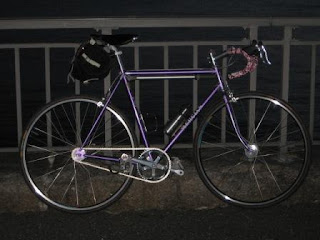 |
| To see more about this bike, go to http://rhp3.com/Scwinn_Superior.htm |
When she commented on my post from the other day, "Velouria" of Lovely Bicycle! raised an interesting question. She says longtime bike mechanics joke about Ross bikes and say things like "we couldn't sell them the first time around, but now kids are buying them second hand."
So, I wonder, how and why does something become "cult," "classic" or simply "retro" when it was scorned, dismissed or ignored when it came out?
One example of what I mean is a Schwinn model that was sold as the "Superior" during the early 1960's and mid-to-late 1970's, and as the "Sports Tourer" during the intervening years. Particularly in the final years of the bike's manufacture, it didn't sell well because other similar bikes from Europe and Japan were lighter, and to many consumers, its filet-brazed joints were indistinguishable from the flash-welds on Schwinn's less expensive models like the Varsity and Continental.
Now I see lots of "wanted" listings for Superiors and Super Sports. I guess one reason why is that they're among the very few filet-brazed frames to be mass-produced. And, although somewhat heavier than the bikes they're supposed to compete against, they were solid, and can be made into good, responsive bikes with modern tires, rims, derailleurs, cables and brake pads. Even though they have long chainstays, and therefore longish wheelbases, they still have a "solid" feel in the rear, where many lightweight bikes (like my old Peugeot PX-10E) could feel whippy. That is no small consideration if you install a rear rack and load it up. Plus, the Superiors and Super Sports had larger tire clearances than most current road bikes, which makes it easy to install fenders and convert the bikes to commuting and touring machines.
Some of what I've just said about those old Schwinn models apply to the Rosses--and, for that matter, many other bikes of their era. Perhaps that's one reason why they're sought-out now.
But sometimes you just can't understand why some things aren't consigned to the dustbin of cycling history after being ignored or scorned the first time they came around. One example is some handlebar tape we threw away in the first bike shop in which I worked. It was shiny; it was slippery; to most of us, there was no rationale for using it--at least then.
Fast-forward a few years. I'm working in another bike shop, and we have to back-order that same tape because our order of it sold out within a day of our receiving it. The difference was that,by the time I was working in my second shop, the Seventies had turned into the Eighties. And we all know what happened to bike finishes: Those elegant silver Cinellis and constructeur bikes, not to mention the understated but meticulous work of American and British framebuilders of that time, was falling out of favor. In its place came what we now call the "dreaded Eighties paint jobs": lots of neon colors and fades.
That tape we threw away at my first shop was now in demand because it was shiny and came in a lot of different colors. Those of you who recall that time know that I'm talking about Benotto tape (which, by the way, was made in Mexico, not in Italy, as is commonly thought).
Even when it became popular, it could be found for less than two dollars. These days, it sells for many times more than that on eBay. If I'm correct, it hasn't been made in some time, which might account for the prices people are paying for it.
Those Rosses, Superiors and Super Sports are no longer being made, either. Yet there are other long-extinct marques of bikes and accessories that aren't sought-after these days. And some of those other bikes and parts have some of the same attributes and assets I've described, as well as others that should make them attractive to somebody. So why do they continue to languish in obscurity while other products, like Ross bikes, are sold within hours of appearing on Craigs List?









